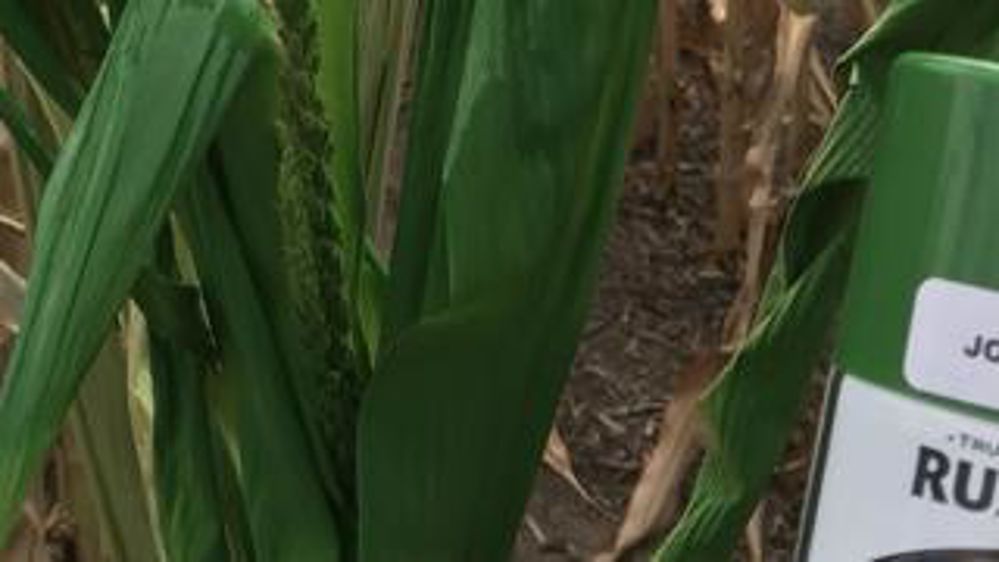Aux États-Unis, tout est bon pour ressusciter les épis
< p lang = "en » dir = "ltr"> Saw this on < a href = "https ://twitter.com/hashtag/agtwitter?src=hash& ; ref_src = twsrc % 5Etfw"> #agtwitter this spring. Am I doing it right ? < a href = "https ://twitter.com/hashtag/itsnotgrowing?src=hash& ; ref_src = twsrc % 5Etfw"> #itsnotgrowing < a href = "https ://t.co/KxvRevyis6"> pic.twitter.com/KxvRevyis6&mdash ; Jeremy Stoecker (@jjsteck) < a href = "https ://twitter.com/jjsteck/status/1025874322504773636?ref_src=twsrc%5Etfw"> August 4, 2018
]]>
«J’ai vu ça sur #AgTwitter au printemps… J’ai fait comme il faut ? #çanepoussepas »
Au Canada, on s’interroge sur les pratiques en colza…
< p lang = "en » dir = "ltr"> Drought. < br > In my immediate area ? < br > Two canola crops, same rainfall. < br > Lessons learned from previous droughts or do we waste precious rainfall and hope it rains in the spring ? < br > Which story should the media portray ? < br > We will need rain to finish crops or yield potential won’t be great < br > 2of2 < a href = "https ://t.co/vIH4GAiUkn"> pic.twitter.com/vIH4GAiUkn&mdash ; Warwick Holding (@Pontaragrain) < a href = "https ://twitter.com/Pontaragrain/status/1026765815930994688?ref_src=twsrc%5Etfw"> August 7, 2018
]]>
«Sécheresse ? Dans ma région ? Deux champs de colza, mêmes précipitations. Est-ce qu’on apprend des sécheresses passées ou est-ce qu’on gaspille nos pluies en priant pour qu’il pleuve au printemps ? Quelle histoire doivent raconter les médias ? Nous aurons besoin de pluies pour terminer la campagne ou le rendement ne sera pas au rendez-vous. »
…Et on ensile avec beaucoup d’avance
< p lang = "en » dir = "ltr"> < a href = "https ://twitter.com/hashtag/AgTwitter?src=hash& ; ref_src = twsrc % 5Etfw"> #AgTwitter need some advice on when to panic and bring silage crew in. With all the heat forecasted worry about keeping enough moisture in the plant to pack it. This crop has changed dramatically since Friday. < a href = "https ://t.co/rBPXHaqfUG"> pic.twitter.com/rBPXHaqfUG&mdash ; James Jasper (@jsjlivestock) < a href = "https ://twitter.com/jsjlivestock/status/1026940254652190720?ref_src=twsrc%5Etfw"> August 7, 2018
]]>
«#AgTwitter j’ai besoin de conseil pour savoir s’il faut déjà paniquer et appeler l’équipe pour l’ensilage. Avec ces chaleurs j’ai peur qu’il n’y ait pas assez d’humidité dans les plantes. Les plantes ont dramatiquement changé depuis vendredi. »
Au Royaume-Uni, solidarité entre exploitants
< p lang = "en » dir = "ltr"> My contribution to help the livestock farmers. Come on guys please follow my example, I’ve not baled for many years but we’re in this together. < a href = "https ://twitter.com/hashtag/YourHarvest?src=hash& ; ref_src = twsrc % 5Etfw"> #YourHarvest < a href = "https ://twitter.com/hashtag/farmershelpingfarmers?src=hash& ; ref_src = twsrc % 5Etfw"> #farmershelpingfarmers < a href = "https ://t.co/1F63XjPcz9"> pic.twitter.com/1F63XjPcz9&mdash ; Andrew Ward (@wheat_daddy) < a href = "https ://twitter.com/wheat_daddy/status/1024673160904548352?ref_src=twsrc%5Etfw"> August 1, 2018
]]>
«Ma contribution pour aider les éleveurs. S’il vous plaît, suivez mon exemple. Je n’avais pas mis en balles depuis des années, mais on est tous dans le même bateau. »
En Australie, on refuse de baisser les bras
< p lang = "en » dir = "ltr"> No dying stock here, no donated feed and no frieght subsidy hay. Just a normal farmer getting on with the job. HELP FARMERS THAT ARE HELPING THEMSELVES. Exit packages for farmers who can ' ; t manage. < a href = "https ://t.co/tddeO8rp07"> pic.twitter.com/tddeO8rp07&mdash ; Angus the rocks Atkinson (@qert100) < a href = "https ://twitter.com/qert100/status/1021911835631480834?ref_src=twsrc%5Etfw"> July 25, 2018
]]>
«Ici pas de bétail mourant, pas de don de fourrage, et pas d’aide au transport de foin. Juste un agriculteur qui fait son métier. AIDEZ LES AGRICULTEURS QUI S’AIDENT EUX-MÊMES. Et des aides à cessation pour ceux qui n’y arrivent plus. »
Les exploitants allemands récoltent un mauvais fourrage en avance
< p lang = "de » dir = "ltr"> < a href = "https ://twitter.com/hashtag/Noternte?src=hash& ; ref_src = twsrc % 5Etfw"> #Noternte im < a href = "https ://twitter.com/hashtag/Mais?src=hash& ; ref_src = twsrc % 5Etfw"> #Mais , um den Schaden in Grenzen zu halten. Mais ohne Kolben wegen Trockenheit während der Blüte. Futterqualität ist schlecht, weil die Stärke aus den Körnern fehlt, doch anhaltende < a href = "https ://twitter.com/hashtag/Trockenheit?src=hash& ; ref_src = twsrc % 5Etfw"> #Trockenheit hätte die Qualität weiter verschlechtert. < a href = "https ://twitter.com/hashtag/D%C3%BCrre?src=hash& ; ref_src = twsrc % 5Etfw"> #Dürre < a href = "https ://twitter.com/hashtag/Emsland?src=hash& ; ref_src = twsrc % 5Etfw"> #Emsland < a href = "https ://t.co/UGX0YWedvH"> pic.twitter.com/UGX0YWedvH&mdash ; Hendrik Hanekamp (@flaemingslord) < a href = "https ://twitter.com/flaemingslord/status/1024764810280554498?ref_src=twsrc%5Etfw"> August 1, 2018
]]>
«#récolteprécoce en #maïs, afin de limiter les dégâts de la sécheresse. Maïs sans épis à cause de la sécheresse pendant la floraison. La qualité du fourrage est mauvaise, parce que l’amidon manque, mais la poursuite de la #sécheresse aurait rendu la qualité encore pire ».
En Pologne, fonte des betteraves
< p lang = "pl » dir = "ltr"> < a href = "https ://twitter.com/hashtag/buraki?src=hash& ; ref_src = twsrc % 5Etfw"> #buraki przy 34°C < a href = "https ://t.co/7PtBlxz6xq"> pic.twitter.com/7PtBlxz6xq&mdash ; Łukasz (@LukaszP85) < a href = "https ://twitter.com/LukaszP85/status/1024639255358959616?ref_src=twsrc%5Etfw"> August 1, 2018
]]>
«#Betteraves sous 34 °C »
Ivan Logvenoff




